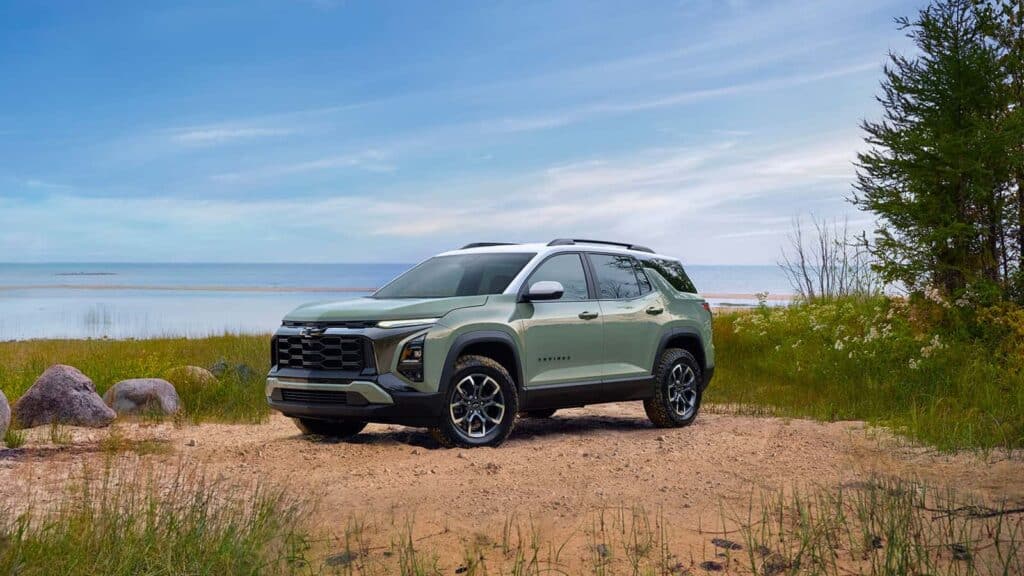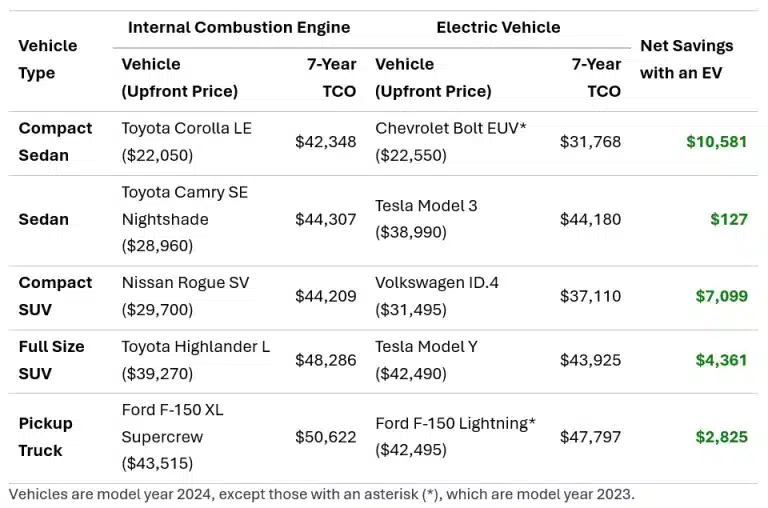New Report Proves Substantial Money Saved by Electric Vehicle (EV) Owners
A current issue in the electric vehicle (EV) industry is that most of the early adopters, a chiefly eco-friendly group, have already bought their EVs. These buyers are mostly single-family homeowners, as home charging is the easiest and cheapest way to charge. In 2024, EV adoption is moving to the early majority consumer segment, a more cost-conscious group of car buyers. The U.S. EV revolution will continue to move quickly in 2024, in spite of this development. These cost-conscious car buyers are encouraged to read the report below by Atlas Public Policy, showing how EV owners are saving thousands of dollars. According to Atlas Public Policy, a highly respected analytics firm specializing in alternative fuel vehicle financing, policy, and technology, the American EV market share reached 12% in December 2023, an astounding new record.

In November 2023, BJ Birtwell, CEO and Founder of Electrify Expo spoke about the early EV adopters on Electrify Podcast live with host Jarod DeAnda. Birtwell said that Electrify Expo’s attendees have shifted from the primarily eco-conscious early electric vehicle adopters to the more mainstream early majority consumer segment, reflecting a widely held opinion among other experts. That widely documented opinion is that American EV adoption is moving to the more pragmatic, cost-conscious, early-majority consumer segment. Early EV adopters and the more mainstream early majority consumer segment are detailed in Everett Rogers’ diffusion of innovations theory.

The diffusion of innovations theory, popularized by Everett Rogers, offers a comprehensive framework for understanding the dynamics behind the adoption of new technologies. It’s an excellent model for experts to study American EV adoption. Rogers posits that the spread of innovations is a methodical process that occurs through specific communication channels over time within a social system. This theory, which has its roots in various disciplines, provides valuable insight into the social behavior patterns that influence the uptake of technological advances.
Rogers’ diffusion of innovations theory categorizes adopters into groups such as innovators, early adopters, early majority, late majority, and laggards, based on their willingness to adopt new technologies. This segmentation helps in understanding the progression of acceptance and the critical mass required for an innovation to achieve widespread popularity. The adoption of electric vehicles (EVs), as noted in Birtwell’s observations, serves as a pertinent example of this theory in action, showcasing how societal and economic factors converge to facilitate the transition from traditional gas-powered vehicles to more sustainable and economically superior electric vehicles.
The cost-conscious early majority consumer segment will be glad to hear that not only is owning an electric vehicle (EV) better for the climate, but it can save owners thousands of dollars. A new study from Atlas Public Policy, conducted on behalf of NRDC (the Natural Resources Defense Council), showed that for every major type of vehicle, owning an EV will save car owners money over a seven-year span, the average amount of time a driver keeps a new vehicle, known as the total cost of ownership (TCO).
TCO (Total Cost of Ownership) shows the overall cost of a product throughout its life cycle. This calculation method accounts for both direct and indirect costs. Consumers knowing about this total cost of ownership gives them a valuable opportunity for a cost comparison over time. This is the recommended method for considering a large purchase, such as a vehicle. TCO calculations can vary depending on the time period used in the reporting. However, a widely used time period in the automotive industry for TCO is seven years. Atlas Public Policy used a seven-year TCO period in its thought-leading report.
Comparing the Cost of Owning The Most Popular Vehicles In The United States, By Atlas Public Policy’s Nick Nigro & Dan Wilkins
Atlas Public Policy’s Nick Nigro, Founder, and Dan Wilkins, Policy Analyst, authored and released a groundbreaking report, “Comparing the Cost of Owning The Most Popular Vehicles In The United States,” in March 2024. The authoritative report analyzed the five most popular gasoline-powered, internal combustion engine (ICE) vehicles sold in 2024.
The report compared the total cost of ownership (TCO), or how much it costs to purchase and drive a vehicle over seven years, with similar electric vehicles that are available for purchase in 2024. The total cost of ownership used in the report includes the purchase price minus the expected resale value, fuel, maintenance and repairs, insurance, taxes, and fees for each vehicle shown.
Atlas Public Policy’s report was supported by the Natural Resources Defense Council (NRDC.) NRDC’s Isabella Sullivan, Schneider Transportation and Climate Fellow, Climate & Energy, released the Atlas Public Policy report in her article, “Cheaper and Cleaner: Electric Vehicle Owners Save Thousands.”
A section of the report below, “Vehicle Comparison Results” highlights each vehicle type, vehicle models, prices, 7-year TCO, and net savings with an EV.
Vehicle Comparison Results

The Economic Advantages of Electric Vehicle (EV) Ownership
According to U.S. Census Bureau data, 91.5% of U.S. households had at least one vehicle available in 2020, compared to 90.9% in 2015. The economic advantages of electric vehicle (EV) ownership are broad and compelling, extending their reach to a wide spectrum of buyers, including those in the market for both new and used vehicles. Even though the initial purchase price of vehicles, whether electric or gasoline-powered, can be a significant financial hurdle for many households, opting for an electric vehicle tends to be the more economical choice in the long run. This is particularly true as more EVs become available on the used car market, bringing the benefits of lower fuel and maintenance costs within reach for buyers at a lower initial investment.
Federal EV Tax Credit, up to $7,500
Furthermore, the federal tax credit for purchasers of new or used electric vehicles adds another layer of financial incentive, with a credit of up to $7,500 if the buyer purchases a new, qualified plug-in hybrid electric vehicle (PHEV) or electric vehicle (EV). If a buyer purchases a qualified used electric vehicle from a licensed dealer for $25,000 or less, the buyer may claim 30% of the sale price up to a maximum credit of $4,000. In January 2024, the credits converted to a point-of-sale discount.
Groundbreaking Findings
With the number of used EVs on the market having tripled over the past three years, the opportunities for garnering savings through the purchase of a used electric vehicle have never been more accessible. This shift not only underscores the growing feasibility and appeal of EV ownership but also highlights the broader implications for sustainable transportation.
Compared to a similar analysis that Atlas Public Policy conducted in 2022, this new study adds to the larger body of research and data showing an overall consistent decrease in EV prices, signaling a broader shift toward affordability in the electric vehicle market. The marked increase in cost savings for electric models, as demonstrated by the significant jump in savings from driving a Chevrolet Bolt compared to a Toyota Corolla, illustrates a trend that stakeholders in the automotive industry cannot ignore.
The analysis in 2022, which highlighted a saving of about $3,000 for Bolt owners, was a significant finding at the time. However, the current study not only reaffirms but also emphasizes the accelerated pace at which the economic benefits of owning an electric vehicle are expanding. Such trends are pivotal, driving consumer choices towards more sustainable and financially viable automotive options and underscore the evolving dynamics of vehicle ownership in the face of advancing technology and environmental considerations.
The findings from the updated study are indeed groundbreaking, solidifying the assertion that electric vehicles are becoming an increasingly economical choice for consumers. It’s remarkable to witness how the financial dynamics are shifting in favor of electric vehicles, particularly in the case of the Chevrolet Bolt’s comparative cost benefits against traditional gas-powered vehicles like the Toyota Corolla. This significant increase in savings, from $3,000 to over $10,000 within a mere two-year span, is indicative of a larger trend toward affordability and sustainability in the automotive market. This evolution is not just limited to the Bolt but is evident across multiple EV models, suggesting that the move towards electric vehicles is not only a win for the environment but also for consumer wallets in the long run.
EVs Offer Reduced Fuel Costs
There are several reasons why we are seeing these vehicle owner savings increase with each year. A fundamental factor contributing to this trend is the lower operational costs associated with electric vehicles (EVs) compared to traditional gas-powered vehicles. Primarily, electric vehicles are cheaper to fuel due to the stable costs of electricity versus the volatile costs of gasoline. When considering the fuel expenses alone, EV drivers typically spend about 40 to 65 percent less annually than their counterparts driving gasoline-powered vehicles. These savings can be further maximized by leveraging time-of-use rates — charging EVs during off-peak hours, such as late night and early morning when the demand for electricity hits its lowest point. This strategy allows for charging at the lowest rates possible. Given that nearly 90 percent of electric vehicle charging occurs overnight at home, these significant savings are not only hypothetical but readily attainable for the majority of EV owners.
EVs Have Reduced Maintenance Costs in Comparison to ICE Vehicles
In addition to the lower operational costs, electric vehicles have fewer mechanical components than their gas-powered counterparts, which translates into reduced maintenance requirements. This inherent simplicity of EVs means there is less that can go wrong, leading to fewer visits to the mechanic. Specifically, the models analyzed show that EV drivers save, on average, 40 percent on repair and maintenance costs. This considerable saving stems from the absence of typical gas-engine parts like exhaust systems, spark plugs, and oil filters, which are prone to wear and tear. Such economies of maintenance not only benefit the vehicle’s owner financially but also add to the convenience and time saved, further enhancing the appeal of electric vehicles.
EV Prices Dropping Fast
Along with the savings from cheaper fuel and maintenance costs, the average up-front prices of electric vehicles have been rapidly declining as technologies advance. From just September 2022 to September 2023, the average price of a new EV has dropped nearly $15,000. This significant reduction in prices is primarily attributed to the decreasing costs of lithium-ion batteries, which constitute a substantial portion of an electric vehicle’s total cost. Impressively, the costs of these batteries have declined 89 percent between 2008 and 2022. Advances in battery technology, coupled with economies of scale, have played a pivotal role in this trend. Additionally, incentives and tax credits offered by governments worldwide have further contributed to making electric vehicles more affordable. These financial benefits have not only helped reduce the up-front cost disparity between electric vehicles and their gas-powered counterparts but also promise to enhance the overall economic advantage of owning an EV as prices continue to decrease. EV prices are dropping fast. In one example, In February 2024, Ford lowered the MSRP of its 2023 Ford Mustang Mach-E; some variants are now cheaper by up to $8,100.
Atlas Public Policy Enables Businesses and Policymakers to Make Informed, Public Interest-Oriented Decisions
Atlas Public Policy stands at the forefront of driving strategic decisions in areas that profoundly impact our societies and the environment. By harnessing cutting-edge, accessible technologies, Atlas develops analytical tools and dashboards that demystify complex data, enabling businesses and policymakers to make informed, public interest-oriented decisions. Their expert advisory services are tailored to address some of the most pressing contemporary challenges. Currently, Atlas is deeply engaged in key work areas such as transportation and building electrification, which play a pivotal role in shaping the transition towards sustainable energy sources. They are also actively involved in climate policy, contributing to the development and implementation of strategies aimed at mitigating climate change. Additionally, Atlas is tackling the problem of disinformation by tracking its spread and impact, which is crucial in a world where information integrity is increasingly under threat. Through these endeavors, Atlas Public Policy is not just influencing current policies but is also shaping a sustainable future.
The Natural Resources Defense Council Defends the Environment and Fights Climate Change
Since its inception in 1970 by New York-based lawyer John H. Adams and his fellow litigators, NRDC has blossomed into a colossal force for environmental advocacy, uniting the prowess of over 3 million members and online activists with the expertise of over 700 scientists, lawyers, and environmental specialists. This formidable assembly is dedicated to tackling the intricacies of the climate crisis, safeguarding wildlife and the pristine wilderness, and upholding the fundamental human rights to breathe clean air, drink clean water, and live in healthy communities. The NRDC was a pioneer in recognizing the power of legal action as a tool for environmental advocacy, setting a precedent for numerous other organizations to follow. Through its relentless efforts, the NRDC remains steadfast in its commitment to protecting the environment and ensuring a sustainable future for generations to come.
Going Electric Saves Money and the Environment at the Same Time
The findings from Atlas Public Policy reinforce a crucial message: transitioning to electric vehicles (EVs) is not just financially wise over the long term but also enhances public health and environmental quality. The compelling evidence that EV ownership is less costly overall makes the case for electric mobility more persuasive than ever. Now is an opportune moment for consumers to pivot away from fossil fuel-dependent transportation, benefiting both their wallets and the planet. This shift is supported by clear data showing that, amidst dropping prices and increasing incentives, electric vehicles stand out as the more economical and eco-friendly choice.

Electric Vehicle Marketing Consultant, Writer and Editor. Publisher EVinfo.net.
Services